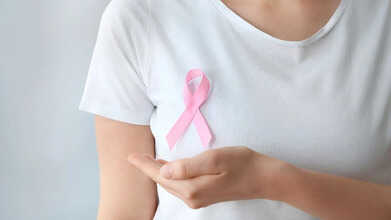- Health Conditions A-Z
- Health & Wellness
- Nutrition
- Fitness
- Health News
- Ayurveda
- Videos
- Medicine A-Z
- Parenting
- Web Stories
8 Natural Ways To Manage Stress With Ayurveda

Natural Ways To Manage Stress With Ayurveda
Modern life is often a juggling act, with stress becoming almost a given. Thankfully, Ayurveda, with its roots in holistic healing, offers a wide range of natural tools for managing stress and finding balance in our lives. Ayurvedic wisdom can be used in several simple self-care practices to cope with stress and bring a sense of calm to your everyday routine.
1. Relaxation Techniques
One of the most effective ways to combat stress is to practice regular relaxation techniques. Meditation, yoga, and deep breathing aren’t just buzzwords—they have a real impact on calming the nervous system. Ayurveda promotes these practices to encourage a natural relaxation response in the body, balancing the mental and physical tension that stress often brings. Try progressive muscle relaxation, which involves tensing and releasing muscles one by one, or simply take a few deep breaths when stress hits.
2. Step Away for a Moment
Sometimes, the simplest solution is the most effective. Stepping away from the source of your stress—whether it’s work, news, or personal responsibilities—can offer immediate relief. Ayurveda encourages taking regular breaks to reset and give your mind space to recover. Even a short walk or a few minutes outside can help you feel refreshed and bring you back to your tasks with a clearer mind.
3. Do What You Love
In times of stress, reconnecting with activities you enjoy can be a powerful antidote. Whether it’s spending time with friends, enjoying a good book, painting, or dancing, doing something that brings you joy can lift your spirits. Ayurveda teaches that engaging in joyful activities nurtures the mind and helps keep stress at bay.
4. Nourish Your Body: Eat Well, Exercise, and Sleep
Good nutrition, regular exercise, and quality sleep are the foundations of a balanced mind and body. Ayurveda emphasizes eating fresh, natural foods that nourish both body and mind. Exercise, even if it’s gentle yoga or a brisk walk, can release tension and improve mood. And let’s not forget sleep—getting enough restorative rest helps the body and mind recover from daily stresses and maintain balance.
5. Talk It Out
Sometimes, all we need is to share what’s on our mind. Talking to someone—a friend, family member, or counselor—can be a great way to process emotions and relieve stress. Ayurveda values connection and community; sharing your feelings with a trusted listener can provide a fresh perspective and lighten the mental load.
6. Limit Drugs and Alcohol
While substances like alcohol or other drugs may seem to offer temporary relief, they often lead to heightened stress in the long run. Ayurveda advocates for natural ways of managing stress, encouraging us to avoid substances that interfere with the body’s natural balance and amplify anxiety.
7. Embrace Aromatherapy
The calming effects of essential oils like lavender have been valued in Ayurveda for centuries. Lavender oil, in particular, is known to soothe the mind and reduce feelings of anxiety. A few drops of lavender oil in a diffuser or a warm bath can create a serene environment that naturally eases stress.
8. Enjoy a Cup of Chamomile Tea
Chamomile tea is a gentle, natural way to unwind. This herbal tea has long been recognized in Ayurvedic traditions for its ability to soothe the mind and calm the stomach, making it a great companion in stressful times. Sipping a warm cup of chamomile tea can help signal your body and mind to relax.
Ayurvedic Therapies for Holistic Stress Relief
Ayurveda also offers specialized therapies for deeper relaxation and stress relief. Treatments like Pizhichil (a warm oil therapy), Shirodhara (a stream of warm oil gently poured over the forehead), and Abhyanga (full-body oil massage) are deeply restorative and calming. These traditional Kerala therapies help detoxify the body and relax the mind, working in harmony with natural processes to bring about a sense of peace and renewal.
Integrating these Ayurvedic practices into your life isn’t about making a drastic change overnight; it’s about gradually building small, mindful habits that help you manage stress with more ease. By embracing these simple, time-tested approaches, you’ll find yourself better equipped to handle life’s challenges with calm and resilience
Aggression And Self-Harm Could Be Due To Early Childhood Trauma: Study Reveals How Brain Rewires Itself

(Credit-Canva)
A new study revealed that childhood trauma could rewire’ your brain, the researchers suggest that this could lead to aggressive and self-harming behavior.
The study, led by Assistant Professor Sora Shin, identified the specific brain pathway that changes after someone experiences trauma early in life. The results were published in the journal Science Advances.
The researchers explained that their findings suggest that aggression and self-harm, while looking different on the outside, might actually come from the same place in the brain. They might both be a result of how the brain deals with pain signals.
Can Trauma Change Your Brain?
The new discovery is crucial because it’s the first time scientists have found a real biological process that explains how trauma, feeling sensitive to pain, and these harmful behaviors are all connected. This new understanding could lead to much more precise and effective treatments for people who struggle with conditions caused by trauma.
The researchers found that early trauma causes a specific communication line in the brain, linking the nucleus reuniens and the hippocampus, which is the pathway that regulates cognitive, executive and fear-learning process, to become overactive.
The increased activity of structures called calcium channels is what makes a person more likely to be aggressive and hurt themselves.
Both feeling upset and hurt physically seem to trigger these behaviors because the brain’s signals have been changed by trauma.
How Does Childhood Trauma Lead To Aggression?
Shin and her team research how bad experiences in childhood change the brain, leading to harmful behaviors in adulthood. Her previous work looked at how trauma can lead to things like binge eating.
Researchers questioned what really drives aggression and self-harm. Is it just feeling anxious or depressed? Or could there be a deeper reason, possibly related to how the brain handles pain, at the very core of these issues?
They explained that the trauma literally increased the activity of the calcium channel. The trauma changed the brain at a molecular level, causing the neuron to become hyperactive, meaning it was firing too much. This excessive activity in that specific circuit is what makes a person more susceptible to becoming aggressive and hurting themselves.
The research also suggested that pain, including emotional pain, might act as the doorway for these harmful behaviors to appear. By clearly identifying the physical connection in the brain between early trauma and its later effects, the study gives a much deeper understanding that goes beyond just asking people how they feel.
How Is Aggression and Self-Harm Linked?
In people who have gone through early childhood trauma, aggression and self-harm often happen at the same time. Doctors and therapists have known about this link for a while, mostly based on what patients tell them and what they observe in clinics.
To back this up, studies show that people who are treated for self-inflicted injuries are five times more likely to also be extremely aggressive. This strongly suggested that there was a single, underlying reason connecting the two behaviors.
Can This Help Treat Trauma?
Shin noted that extreme aggression is a serious social problem, and self-harm is a major concern for many people seeking treatment. She believes that their study provides clearer, more objective insights into the brain circuits that cause these outcomes. This understanding could eventually lead to the creation of more effective therapies to help people dealing with trauma's lasting impact.
Is President Trump Healthy? Ask Netizens As Trump Slept While Dr Oz Spoke On Dementia And Obesity At The Press Conference

Credits: X
Health concerns around President Donald Trump has again sparked as many noticed him sleeping during the Thursday Press Conference in the Oval Office. The press conference was held to announce a deal with drugmakers on lowering cost of obesity drugs.
While the meeting had to be cut short after a man collapsed, videos from before the very incident showed president Trump sitting with his eyes closed. He seemed to have slumped on his chair. Many on X observed his actions, sparking health concerns. One X user wrote: "Trump was literally slumped over asleep during this conference. No wonder they keeping on doing 6 month brain scans." While another user wrote: "Trump just sleeping slumped over in his chair..." Another user wrote: "Dr Oz linking obesity to dementia while Trump's slumped over at his desk is absolutely a choice..."
Many users also joked about looking at his brain scans, as one of the users wrote: "What I would give to see that MRI report!" Another noted: "Trump looks seriously unwell. There are definitely medical issues being hidden from the public."
Trump Dozing Off At Official Announcements
This is not the first time President Trump has dozed off during an official announcement. Donald Trump appeared to momentarily doze off during a press conference which was held with Israeli Prime Minister Benjamin Netanyahu. Media outlets have reported that the president struggled with his words and when it was Netanyahu's turn to speak, Trump looked completely disassociated, and even appeared to doze off momentarily. Trump was seen "jolting as he woke himself up".
The video from the press conference shows the president standing at the podium with his eyes closed, and within a few seconds, he was startled, blinking his eye, while he tapped his fingers on the podium in a manner to keep himself awake.
Then a few seconds later again, Trump appeared to have been sleeping again, but this time he moved his body to wake himself back again.
These clips from the past and the recent press conference have again sparked concerns around the president's health. However, no official statement on Trump's health has been released. In fact, his physician had pronounced him in "excellent overall health".
However, his past behaviors have raised concerned about his cognitive decline.
After two psychologists raised questions about the US President Donald Trump's mental health, saying that he showed signs of frontotemporal dementia (FTD), questions about his cognitive health is again intensified after Dr Narinder Kapur, a consultant neuropsychologist and visiting professor at the University College London said that president's behavior over the last six months has been "quite odd and strange," as reported by Express, UK.
Kapur said that Trump's suggestion that Canada should become the 51st US state. and his desire to "take over Greenland", and his controversial comments linking autism with paracetamol are really "bizarre". “Even though he’s probably been led a bit by [Robert F.] Kennedy [Jr.] on that, still for Trump to say the things he did was really quite odd and bizarre,” he said.
While Kapur did not diagnose Trump with dementia, he did suggest the possibility of frontotemporal dementia. “If one was thinking about the various possible dementias he’s got, certainly frontotemporal dementia is one of them, because some of his behavior has been really quite bizarre,” he said, adding that an Alzheimer’s test would help clarify concerns.
This Common Pill May Cut Breast Cancer Risk in Women, New Study Finds

Credits: Canva
Scientists have found that a type of morning-after pill may help protect young women from developing breast cancer. The drug, which is already available for free on the NHS, blocks the hormone progesterone and has been shown to trigger changes in breast tissue that make it less likely for cancer to form. One woman who chose to undergo a double mastectomy as a preventive measure says the discovery “offers hope” to others at high genetic risk of the disease.
A team from Manchester University studied 24 women between 2016 and 2019 who were at high genetic risk of breast cancer due to family history. These women, aged between 34 and 44, took ulipristal acetate, and researchers observed that their breast tissue became less dense and less stiff, conditions that make it harder for cancers to grow.
What Is Ulipristal Acetate?
Ulipristal acetate is commonly prescribed as emergency contraception and to treat moderate to severe uterine fibroids. It works by blocking progesterone receptors, delaying ovulation, and altering the uterine lining to prevent pregnancy, as per 1mg.
Earlier research has also shown that triple-negative breast cancer tends to return or spread more quickly than other breast cancer types, especially within the first few years after diagnosis.
Is Ulipristal Acetate A Promising Step Toward Prevention?
Dr Sacha Howell, lead author of the study and Consultant Oncologist at The Christie Hospital in Manchester, said, “Our research shows that progesterone has a vital role in the development of breast cancer among high-risk women. By blocking its effects, ulipristal acetate and similar drugs could serve as effective preventive treatments,” he explained.
The findings suggest that using ulipristal acetate to prevent breast cancer may one day help women at higher risk before menopause.
Currently, these women face only two preventive options: long-term hormone therapy, which can cause side effects like higher blood clot risk and reduced bone density, or preventive surgery to remove part or all of the breasts.
The Need for Better Options
Dr Simon Vincent, chief scientific officer at Breast Cancer Now, which funded the study, said, “We urgently need better preventive treatments that protect both health and quality of life for women at high risk of breast cancer. Repurposing existing medications, like ulipristal acetate, could be a major step forward. Right now, the available options—preventive surgery or hormone therapy can have a serious impact on both the body and emotional wellbeing.”
The study, published in Nature, found that ulipristal acetate reduced the growth of certain breast cells known as luminal progenitors. These cells can develop into triple-negative breast cancer, an aggressive form of the disease that often affects younger and Black women.
Disclaimer: This article is for informational purposes only and should not be taken as medical advice. Always consult a qualified healthcare professional before starting, stopping, or changing any medication or treatment.
© 2024 Bennett, Coleman & Company Limited

